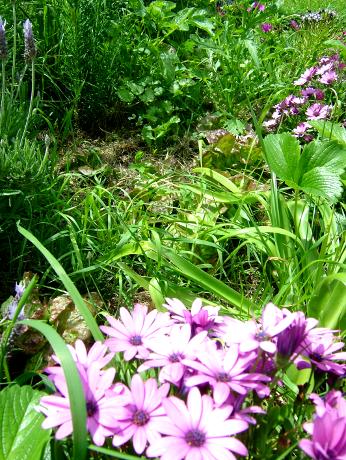Polyculture
Rich, diverse gardens for low effort - high yield
 At the other end of the spectrum from monocultures, polycultures are mixed plantings of various species that work together and may imitate naturally occurring collections.
At the other end of the spectrum from monocultures, polycultures are mixed plantings of various species that work together and may imitate naturally occurring collections.
Unlike monoculture, which is prone to pest and disease, depletes and degrades soil, polycultures are ecosystems in themselves, utilising the balancing and collaborative effects of nature.By selecting various plant species with supporting or complimentary properties it is possible to create great looking environments that produce food, enrich the soil, help retain moisture, encourage beneficial insects and discourage unwanted ones.
All that is required is a basic understand of the various requirements and characteristics of different plants to assemble your own collections. Alternatively there are many resources online that offer suggestions that may be suitable for your climate.
My most recent attempt includes:
Lupins - Tall and leafy they fix nitrogen in the soil, generate organic matter, shade the soil to prevent it drying out, slow down the wind and have an attractive blue flower that bumblebees love.
Strawberries - A ground cover that helps reduce evaporation and, obviously, tasty fruit.
Ornamentals - Being located on the edge of the lawn, near our deck and living area I included an assortment of flowers for visual appeal and for the bumblebees.
Oriental radish & Potatoes - Help break up the soil with their vigorous and substantial roots 'injecting' organic matter to build the soil from the bottom up. Radishes should be left to flower and seed collected and some inevitably dropped in place.
Salad Greens - Assorted lettuce varieties and some herbs such as dill and coriander.
Rhubarb - A perennial and caster of heavy shade.
Bush beans - Improve the soil while producing green or dried beans.
The general idea is to harvest things as they come ready or need thinning out and, where space opens up, push in some new seeds.
We are already harvesting salad greens, the soil looks much improved and beans are popping up. Remember, when removing edibles or plants you no longer want for some reason, leave as much of the green material tucked around the bases of the remaining plants as possible. This will act as a mulch, encourage worms and scratching birds (who add manure) and generally improve the condition of the soil.

